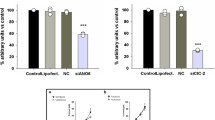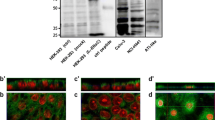Abstract
Respiratory tissues can be damaged by the exposure of airway epithelial cells to reactive oxygen species (ROS) that generate an oxidative stress. We studied the effects of the hydroxyl radical ·OH, for which there is no natural intra- or extracellular scavenger, on a Ca2+-activated, non-selective cation channel (NSCCa) which might participate in the transepithelial Na+ fluxes involved in the maintenance of the cytosolic [Na+] ([Na+]i). We identified and characterized NSCCa in inside-out excised membrane patches from cells of the human bronchial cell line 16HBE14o– and exposed the cytoplasmic side of NSCCa to H2O2 or ·OH created in front of the patch pipette. In these cells, the NSC channel was Ca2+ (above 0.1µM) and voltage dependent. The channel's low open probability (P o) at hyperpolarized voltages increased rapidly to a very high value upon short exposure (seconds) to ·OH or to H2O2 in a bath solution containing millimolar [Ca2+]. This sensibility to ROS was reversible on wash-out of the oxidants. Long exposure (several minutes) to ·OH in a bath solution containing 10–7 M Ca2+ activated the channel irreversibly, a finding that has pathophysiological implications. The functioning of the NSCCa protein channel may be modified by the intracellular redox status and the reversibility of the sensitivity to ROS depends on [Ca2+]i. The role of NSCCa channels in airway epithelia is not yet understood, but might conform to what might be expected of an NSC channel: increase in [Na]i following intracellular exposure to ·OH or H2O2. Reversible or irreversible excessive opening of cation channels may induce gradual cellular responses, including changes in Na+/K+-ATPase activity, cell volume regulation, membrane polarization, activation of transcription factors required for the expression of genes of cytokines or chemokines, apoptosis and necrosis, thus triggering inflammation.
Similar content being viewed by others
Author information
Authors and Affiliations
Additional information
Electronic Publication
Rights and permissions
About this article
Cite this article
Jeulin, C., Dazy, AC. & Marano, F. Effects of hydrogen peroxide and hydroxyl radicals on the cytosolic side of a non-selective cation channel in the cultured human bronchial epithelial cell line 16HBE14o–. Pflügers Arch - Eur J Physiol 443, 574–583 (2002). https://doi.org/10.1007/s00424-001-0733-5
Received:
Revised:
Accepted:
Published:
Issue Date:
DOI: https://doi.org/10.1007/s00424-001-0733-5




